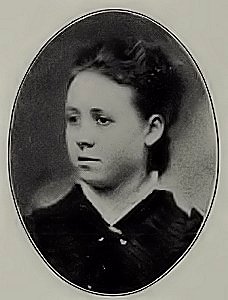Introduction
Born: January 21, 1859, Saginaw County, Michigan.
Died: March 8, 1946, Chelsea, Michigan.
Buried: Midland Cemetery, Midland, Michigan.

Born: January 21, 1859, Saginaw County, Michigan.
Died: March 8, 1946, Chelsea, Michigan.
Buried: Midland Cemetery, Midland, Michigan.

Ida was the daughter of John F. Briggs and Arvilla I. Bigelow, and wife of James Harvey Budd (married January 7, 1880).
Mrs. Ida M. Budd first opened her eyes in a log cabin, in Saginaw [County], Michigan, in 1859.
When she was three years of age, her parents moved to Milford, Mich., where from earliest recollection she drank deeply of the natural beauties in which the place and its vicinity abounded; made friends of the trees and their feathered denizens; of the hills, the Huron river and the small creek which flowed past her home to join it; traced pictures in the drifting clouds and became, indeed, a child of nature.
Coordinate with her love of nature, became her love of books.
From the time I had my first knowledge of an institution called school,she writes,I felt an ardent longing to be part of it.In her fifth year she was permitted to be a
visitorat school, and during that wonderful morning, at that early age, the answer to the perplexing question concerning her life-occupation was charmingly unfolded to her—she would be a school teacher.At ten years she began her studies. At fifteen, although hampered by ill health, she received her first teacher’s certificate.
Her father’s return from the [American civil] war in 1865, bringing with him his copy of
The Army and Navy Hymn Bookawakened her first interest in hymnology and she speedily obtained mental possession of such treasures as Jesus, Lover of My Soul, Rock of Ages, etc., singular mental food for a child of six years, at which time she first attended Sunday school and became the owner of a song book,Happy Voices,all hervery own.As a child she scribbled verses, but as years passed she became familiar with the masterpieces of American poets, such as Evangeline, Hiawatha, Bitter Sweet, and others, which convinced her that the mystic spirit which produced them resided, in some degree, in her own being.
Her first poem was printed in 1881; her second in 1890, in the Detroit Free Press under a nom de plume.
As a writer of verse for children she has few equals, and no superior, and it gives me pleasure to know that I composed the music for her first and many subsequent poems of childhood, some of which have been reprinted in foreign lands.
Her best known hymn, perhaps, is Leaving All to Follow Jesus. John G. Whittier, with his simple, trusting faith in the Eternal Goodness, has furnished much of the inspiration for her work, and since her first acquaintance with his writings he has been her favorite poet.
The Youth’s Companion paid her $20.00 for her poem Resurgam, printed in the Easter number for 1904. Her writings include a number of short stories, sketches, and miscellaneous articles.
These waifs of mine,she writes,have brought me many delightful friendships and a big account in the bank of happy memories, and I am led thankfully to believe that they have also, in some instances at least, been helpful to others.Charles H. Gabriel
The Singers and Their Songs, 1916